It looks like you're using an Ad Blocker.
Please white-list or disable AboveTopSecret.com in your ad-blocking tool.
Thank you.
Some features of ATS will be disabled while you continue to use an ad-blocker.
share:
i say we just hire bruce willis and have him bring his own team up to space drill drop a nuke get out of there and blow it up.
we might want to warn the aliens first though, dont need them complaining about radiation and space dust hitting there ships.
reply to post by Frankenchrist
Haha.. well considering they are "past" civilizations, I would wager nothing.
Also, the comment described in OP is overkill. Probably nothing we could do. It wouldn't matter where it hit it would destroy nearly all life on earth (and by that I mean all but the bugs and shrimps). I would think we may spy it a little earlier than a week though given the size, but maybe not. I guess our best bet would be to bombard it with everything we have got and try to alter path. We may have weapons now that could do the job.
No idea really.
Haha.. well considering they are "past" civilizations, I would wager nothing.
Also, the comment described in OP is overkill. Probably nothing we could do. It wouldn't matter where it hit it would destroy nearly all life on earth (and by that I mean all but the bugs and shrimps). I would think we may spy it a little earlier than a week though given the size, but maybe not. I guess our best bet would be to bombard it with everything we have got and try to alter path. We may have weapons now that could do the job.
No idea really.
Originally posted by kennvideo
I was hoping the clowns and chuckle getters wouldn't show up... I am really let down that when putting forth a question and specifically requesting no jokes some members must act like buffoons.... That's really sad...
Get over it. When brainstorming for ideas you don't discourage any kind of response. If someone were to facetiously suggest a trampoline it might prompt some scientist to realize, "Yes, that's it! We can saturate that portion of outter atmosphere and space in the path where it is expected to breach with Super Flubber MMX gas and cause a deflection." Discouraging any kind of input could possibly prevent a solution from being found.
edit on 24-3-2012 by Erongaricuaro because: (no reason given)
On a serious note op.
Start digging.........have someone gather as much food and water that is possible, while you are digging.
Do not stop digging for any reason what so ever. If you could get a few people to help dig, I think you could get a nice little underground shelter built in seven days.
Store as much fuel and firewood as you can. And figure out a way for defenses, as good as you can with what you have..
one thing is for sure.....It will suck.
Start digging.........have someone gather as much food and water that is possible, while you are digging.
Do not stop digging for any reason what so ever. If you could get a few people to help dig, I think you could get a nice little underground shelter built in seven days.
Store as much fuel and firewood as you can. And figure out a way for defenses, as good as you can with what you have..
one thing is for sure.....It will suck.
edit on 24-3-2012 by liejunkie01 because: (no reason given)
reply to post by Foppezao
ICBM's are designed to carry a payload into low orbit, then release them so they re-enter over their targets. They are not designed to go into space, they don't carry enough fuel to make the burns required to achieve escape velocity. A rocket in orbit has NOT escaped gravity, as you claim, if it had, then it would have flown off into space. What you see when a rocket is in orbit is it falling in freefall around the planet, but by changing the eccentricity of the orbit, the ship always falls beyond the arch of the planet, thereby missing it.
If a rocket was launched into orbit, it would fall back to the ground on the next pass, because it has not escaped the earths gravity. Using a series of rocket burns, they make the eccentric (oval) orbit, less and less eccentric (more circular) until the object misses falling back to earth on the next orbit.
Pardon my crappy graphics here, but it something like this:
This is a highly eccentric orbit, immediately following the launch, that will bring the craft right back to the ground:
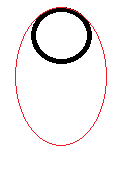
Using a pro-grade burn, they move the Periapsis (closest point in the orbit) out from the plant, but its still a pretty eccentric orbit:
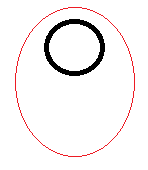
If they keep making pro and retograde burns at the right time, they can get the eccentricity as low as possible, which makes for a stable orbit:

Or...
If they continue to make only pro-grade burns they can finally achieve escape velocity:

Rockets themselves are complex custom made pieces of precision engineering that are ordered as needed in advance of a mission. NASA does not keep a warehouse of “ready to go” rockets configured for whatever scenario might come up on a seconds notice. That's why rescue in space has always been considered a non-option. Toward the end of the shuttle program, for certain missions, they were being forced to prep two shuttles at a time to attempt a rescue if needed, but everyone knew that it was just for show because of the bad press over Columbia. It was costing them twice as much time and money just to have that backup moved to the pad.
The Voyagers were sent on Titan IIIE-Centaur rockets, which have not been in production since 2005. They used low power, time consuming routes that allowed them to use planets gravity to pull, and slingshot them along their paths (gravitational assist trajectories ). In the scenario we're talking about here, we would not have years to build, outfit, prep, and launch a rocket, then wait while it built up enough speed to reach its target.
ICBM's are designed to carry a payload into low orbit, then release them so they re-enter over their targets. They are not designed to go into space, they don't carry enough fuel to make the burns required to achieve escape velocity. A rocket in orbit has NOT escaped gravity, as you claim, if it had, then it would have flown off into space. What you see when a rocket is in orbit is it falling in freefall around the planet, but by changing the eccentricity of the orbit, the ship always falls beyond the arch of the planet, thereby missing it.
If a rocket was launched into orbit, it would fall back to the ground on the next pass, because it has not escaped the earths gravity. Using a series of rocket burns, they make the eccentric (oval) orbit, less and less eccentric (more circular) until the object misses falling back to earth on the next orbit.
Pardon my crappy graphics here, but it something like this:
This is a highly eccentric orbit, immediately following the launch, that will bring the craft right back to the ground:

Using a pro-grade burn, they move the Periapsis (closest point in the orbit) out from the plant, but its still a pretty eccentric orbit:

If they keep making pro and retograde burns at the right time, they can get the eccentricity as low as possible, which makes for a stable orbit:

Or...
If they continue to make only pro-grade burns they can finally achieve escape velocity:

Rockets themselves are complex custom made pieces of precision engineering that are ordered as needed in advance of a mission. NASA does not keep a warehouse of “ready to go” rockets configured for whatever scenario might come up on a seconds notice. That's why rescue in space has always been considered a non-option. Toward the end of the shuttle program, for certain missions, they were being forced to prep two shuttles at a time to attempt a rescue if needed, but everyone knew that it was just for show because of the bad press over Columbia. It was costing them twice as much time and money just to have that backup moved to the pad.
The Voyagers were sent on Titan IIIE-Centaur rockets, which have not been in production since 2005. They used low power, time consuming routes that allowed them to use planets gravity to pull, and slingshot them along their paths (gravitational assist trajectories ). In the scenario we're talking about here, we would not have years to build, outfit, prep, and launch a rocket, then wait while it built up enough speed to reach its target.
edit on 3/24/2012 by defcon5 because: (no reason given)
What an interesting question. What I am going to say is the truth of this circumstance......unless the object could be deflected, nothing can be done
to stop it, not an object moving at a high rate of speed and of that size. Surely there is nothing common civilians could resolve that the government
"think tanks" of the world cannot figure out. I would highly recommend the public be notified no more than 6 to 12hrs of impact, as this would give
some the opportunity to attempt survival. Any sooner of a notice would result in worldwide chaos. The 6 to 12hr time frame would only allow enough
time to run for cover. Anyone who has been following the world news and has been putting the pieces together knows that this will eventually happen.
Governments have been prepping for something they know is coming. In closing let me say this, if nukes were used to attempt to break this object up,
it would also contaminat the incoming fragments as radioactive. Wherever they landed would be equivelent to a massive "dirty bomb"....whether it
impacted on land or sea, the results would be catostrophic. I would also like to apologize for the "dogs" who have responded to this thread in a
joking and disrespectful manner, when you specifically asked them not to. Good fortune to you with your endovor.
reply to post by Frankenchrist
I agree- with our current technology, the only thing we can do is BLOW IT UP -
Or another scenario, if we were to be hit in 7 days, the Govt might actually reveal new tech!
Either way- If it were big enough, were doomed unless the opening in the north pole shot us out of the way in the nick of time
I agree- with our current technology, the only thing we can do is BLOW IT UP -
Or another scenario, if we were to be hit in 7 days, the Govt might actually reveal new tech!
Either way- If it were big enough, were doomed unless the opening in the north pole shot us out of the way in the nick of time
reply to post by kennvideo
"Its wing span?" OOMMGG........It's MOTHRA!
Its wing span is five miles wide and two miles high and will arrive in one week.
"Its wing span?" OOMMGG........It's MOTHRA!
we would have to place something in front of it big enough to cause a deflection.
in other words, we'd be dead.
in other words, we'd be dead.
It's ust a meteor bro. It would take a massive asteroid to significantly impact the world. Meteors i am not worried about, asteroids, a little more
so. Most meteors never hit the ground and the ones that are "large" are basketball sized (in most cases) by the time they hit the ground. The one
that hit in the dinosaurs time was supposedly 6-7 miles long and it's tale stuck up out of the sea 6 miles. Unless it's a mile wide/long i wouldn't
be significantly worried.
Moving it with a nuke is the dumbest idea I have heard. If that fails, we just added a highly radioactive bomb that would be a lot worse.
If only we could split it so half of it dropped in the Pacific Ocean and half in the Atlantic.
We could flush America of the 2 coastal areas.
Middle America would be better off maybe......
We could flush America of the 2 coastal areas.
Middle America would be better off maybe......
The thread really got me to wondering and looking a bit...and I think the question is....what weapons do we REALLY have compared to what is publicly
claimed? By we..I mean the human race as a whole. It'd be in everyone's interests to fess up on any real BIG ones someone's been hiding. (looks
over at Russia... )
IF nations have a few very BIG nukes still around or new ones no one knows about, then I'd say the second and only serious question and decision involved becomes....how much are we willing to lose?
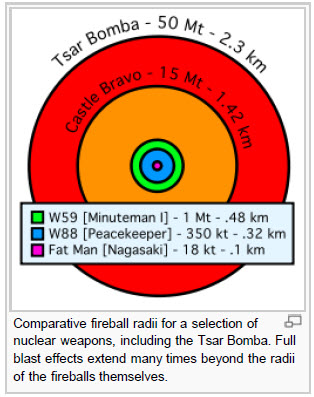
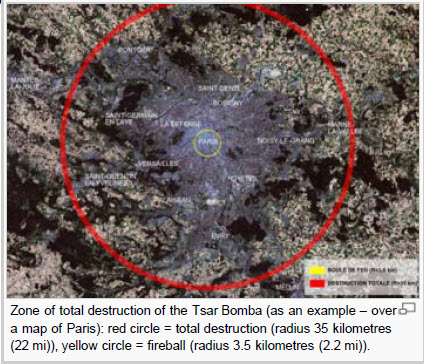
One wouldn't do it....
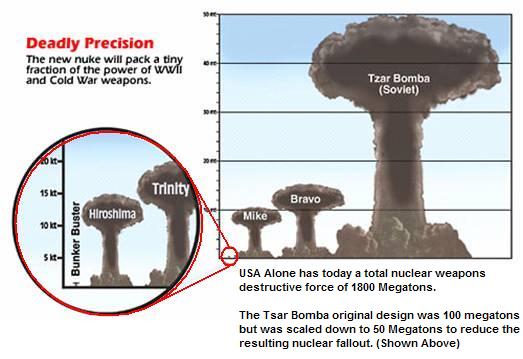
but a half a dozen of them at the top of the Tzar Bomba scale of things would obliterate your incoming object...by my estimation.....if it's 5 miles wide and 2 miles thick. It's not a question of can we.....but how much damage would the little guy actually do, for how much damage the response would cause?
I think it's safe to say that every satellite in space on the detonation side of Earth would just kinda cease to exist...and the ones clear around the other side would be more than a little toasted. Would the series of enormous EMP's from space leave ANYTHING on that half of Earth functioning at any level? lol.....
The object would do how much damage if we just set a perimeter, broke out the beer and lawn chairs and watched it come right on in? It isn't a "It's the size of Texas" moment....but it seems the only way we'd have to respond would pretty much erase a couple hundred years of progress in a bright flash. (actually..several of them. )
IF nations have a few very BIG nukes still around or new ones no one knows about, then I'd say the second and only serious question and decision involved becomes....how much are we willing to lose?


One wouldn't do it....

but a half a dozen of them at the top of the Tzar Bomba scale of things would obliterate your incoming object...by my estimation.....if it's 5 miles wide and 2 miles thick. It's not a question of can we.....but how much damage would the little guy actually do, for how much damage the response would cause?
I think it's safe to say that every satellite in space on the detonation side of Earth would just kinda cease to exist...and the ones clear around the other side would be more than a little toasted. Would the series of enormous EMP's from space leave ANYTHING on that half of Earth functioning at any level? lol.....
The object would do how much damage if we just set a perimeter, broke out the beer and lawn chairs and watched it come right on in? It isn't a "It's the size of Texas" moment....but it seems the only way we'd have to respond would pretty much erase a couple hundred years of progress in a bright flash. (actually..several of them. )
7 days to sort something out ??
Whatever we did would have to be quick,wouldn't have time to build anything i don't think so we either find the biggest shuttle we have,fill it up with some kind of explosive & collide with it 7 hope for the best.
or
enjoy what life we have left & hope it's over quickly.
good thread
Whatever we did would have to be quick,wouldn't have time to build anything i don't think so we either find the biggest shuttle we have,fill it up with some kind of explosive & collide with it 7 hope for the best.
or
enjoy what life we have left & hope it's over quickly.
good thread
Lasers might do it. Get as many space lasers to point at it and shoot continuously, surely that would either deflect it or slow it, thusly missing
Conky!
I found another graphic to help and I was surprised at the numbers.
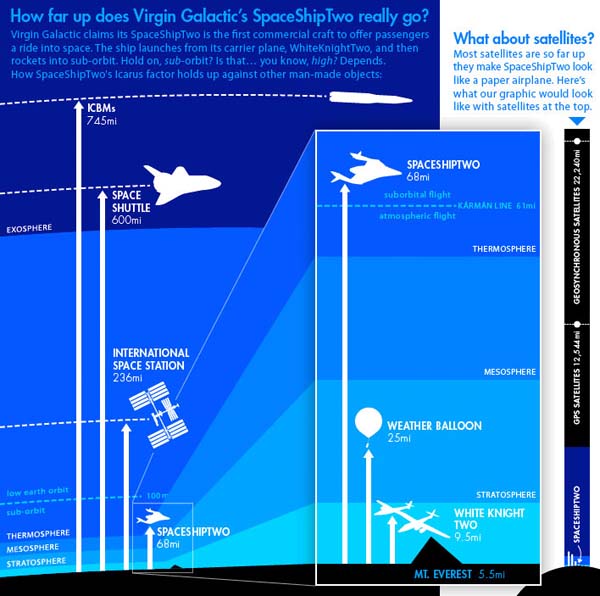 Source
Source
This was made to show SpaceShip 2 and how low it's actually going, but it also seems to indicate the Shuttle wouldn't go nearly high enough and ICBM's....Well.. It's lose/lose I suppose. Do we lose big or lose small, and who is defining each end of the scale. It would be a very interesting thing to see play out, to be sure.

This was made to show SpaceShip 2 and how low it's actually going, but it also seems to indicate the Shuttle wouldn't go nearly high enough and ICBM's....Well.. It's lose/lose I suppose. Do we lose big or lose small, and who is defining each end of the scale. It would be a very interesting thing to see play out, to be sure.
With only a week. I think we could try blowing the thing up. We have what we need to do that now (I believe). If we couldn't intercept it in space,
it would be rough going here on earth.
Hang tight.
Hang tight.
new topics
-
Shane Gillis commercial
Jokes, Puns, & Pranks: 2 hours ago -
Elon Says It’s ‘Likely’ He Buys Tanking MSNBC
Political Ideology: 4 hours ago -
Montelukast affects brain, caused 5 year old to attempt suicide
Medical Issues & Conspiracies: 5 hours ago -
Jaguar Rebrand Video Causes "WTF?" Moment - Seriously Weird
Automotive Discussion: 7 hours ago -
Let's start a conspiracy
General Conspiracies: 8 hours ago -
What Joe Rogan said Vs The View
Dissecting Disinformation: 11 hours ago
top topics
-
Biden's "Reckless" Decision To Escalate Russia-Ukraine War
World War Three: 12 hours ago, 16 flags -
Jaguar Rebrand Video Causes "WTF?" Moment - Seriously Weird
Automotive Discussion: 7 hours ago, 14 flags -
Elon Says It’s ‘Likely’ He Buys Tanking MSNBC
Political Ideology: 4 hours ago, 14 flags -
What Joe Rogan said Vs The View
Dissecting Disinformation: 11 hours ago, 11 flags -
Montelukast affects brain, caused 5 year old to attempt suicide
Medical Issues & Conspiracies: 5 hours ago, 11 flags -
Shane Gillis commercial
Jokes, Puns, & Pranks: 2 hours ago, 2 flags -
Let's start a conspiracy
General Conspiracies: 8 hours ago, 1 flags
active topics
-
The Acronym Game .. Pt.4
General Chit Chat • 979 • : JJproductions -
What Joe Rogan said Vs The View
Dissecting Disinformation • 20 • : watchitburn -
Is Russia Using a New Type of Beam Weapon Against Ukraine?
Weaponry • 22 • : Zaphod58 -
Putin will warn civilians in targeted areas
World War Three • 48 • : annonentity -
Here is why Western leaders in NATO have zero fear of nuclear warfare. At all. Zero.
World War Three • 7 • : yuppa -
Elon Says It’s ‘Likely’ He Buys Tanking MSNBC
Political Ideology • 60 • : watchitburn -
Montelukast affects brain, caused 5 year old to attempt suicide
Medical Issues & Conspiracies • 6 • : RazorV66 -
Well, here we go red lines crossed Biden gives the go ahead to use long range missiles
World War Three • 326 • : yuppa -
Well we know Putins ICBMs won't fail in their silos
World War Three • 171 • : yuppa -
Jaguar Rebrand Video Causes "WTF?" Moment - Seriously Weird
Automotive Discussion • 16 • : BeyondKnowledge3
